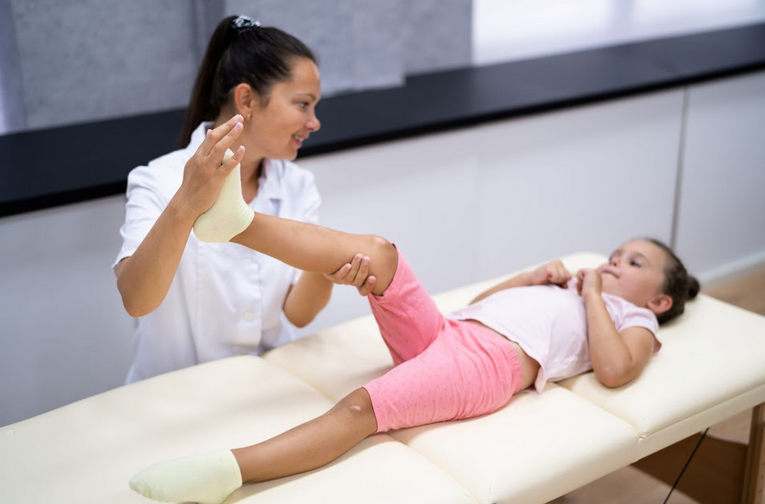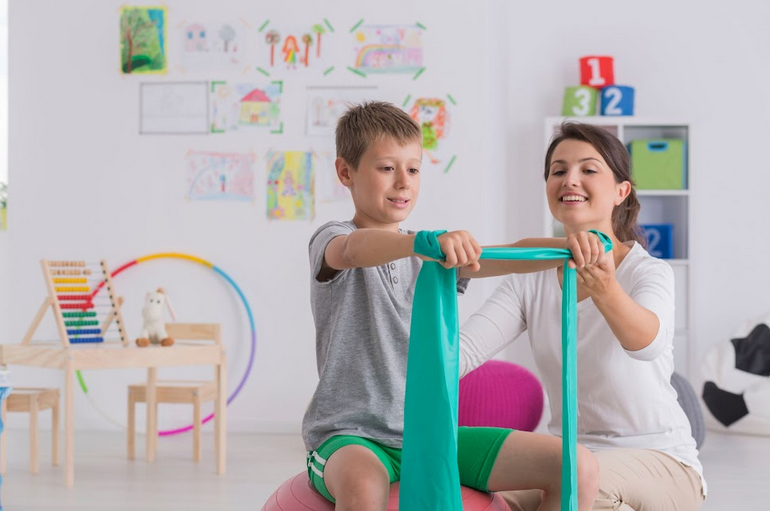The importance of pediatric physiotherapy is becoming increasingly recognized for its contribution to the healthy growth and development of children. Pediatric physiotherapy, a specialized branch of physical therapy focused on children and adolescents, helps to ensure that children are equipped with the physical skills they need to explore, play, learn, and eventually lead healthy, active adult lives.
This article will explore the role of pediatric physiotherapy in promoting healthy development in children and how it builds strong foundations for a lifetime of physical well-being.
Motor Development
The journey of motor development begins in infancy and progresses throughout childhood, with children continually acquiring new skills and refining existing ones. This development process encompasses both gross motor skills and fine motor skills. Gross motor skills utilize the larger muscle groups and involve movements such as crawling, walking, running, and jumping. In contrast, fine motor skills involve the small muscles, particularly in the hands, allowing a child to perform tasks such as picking up small objects, drawing, or buttoning a shirt.
Pediatric physiotherapy plays a vital role in enhancing this complex process of motor development. By understanding the developmental milestones that children typically reach at different ages, physiotherapists can identify delays or abnormalities in motor development. If a child struggles with certain skills, therapists can design activities to target those specific areas and promote progress.
In a pediatric physiotherapy session provided by reputable services like Active Ability, therapists use a variety of carefully curated exercises and activities to stimulate both gross and fine motor skills. Take the simple act of playing catch, for example. This seemingly simple game promotes various gross motor skills such as hand-eye coordination, throwing, and catching.
On the other hand, threading beads onto a string—a classic activity used by therapists—encourages the development of fine motor skills. The child must use precision and control to successfully thread each bead, thereby enhancing their hand-eye coordination and fine motor control.
Pediatric physiotherapists strive to create a fun, engaging, and encouraging environment to motivate children to participate in these activities. This type of positive reinforcement, coupled with activities tailored to a child’s developmental stage and interests, can significantly enhance their motor development. The child is not merely playing; they are learning, developing, and mastering essential motor skills through play.
Muscle Strength And Balance
In childhood, physical activities, from simple ones like standing from a seated position to complex ones like participating in a sports event, hinge on adequate muscle strength and balance. These two components are often taken for granted, but they underpin almost all daily movements.
Muscle strength is not about having bulky muscles—it’s about having muscles that are strong enough to enable a child to participate in various activities, from the playground to the classroom. It’s what allows a child to climb a flight of stairs, carry a backpack, or participate in a school sports day. On the other hand, balance, often overlooked, is an integral component of one’s everyday functioning. It’s what enables a child to walk on an uneven path, stand on one foot to kick a ball or maintain posture while sitting at a desk.
Pediatric physiotherapy has an arsenal of techniques to boost muscle strength and balance. Therapists employ specific exercises to increase the strength of various muscle groups gradually. For instance, climbing activities can be excellent for enhancing lower body strength, while activities involving lifting or moving objects can build upper body strength.
To promote balance and coordination, therapists might use equipment such as balance boards, foam pads, or even simple exercises like standing on one foot. Obstacle courses are a favorite in pediatric physiotherapy. They can be designed in numerous ways to challenge a child’s balance, coordination, strength, and agility, all while making the session fun and engaging.
Consistent focus on muscle strength and balance not only empowers children to perform everyday tasks with ease but also lays a robust foundation for active participation in more demanding physical activities, including sports, as they grow older. By promoting strength and balance, pediatric physiotherapy is setting children up for a future of physical competence, encouraging lifelong habits of physical activity and overall health.

Posture And Alignment
Good posture and proper alignment are more than just about standing tall and looking confident. They’re critical to the health and functionality of a child’s musculoskeletal system. This importance stems from the role that posture and alignment play in preventing various physical complications, such as back and neck pain, joint issues, and musculoskeletal imbalances.
Children are in a phase of rapid growth and development. This stage makes them highly susceptible to developing posture and alignment issues, which, if not addressed in time, can lead to permanent changes in their skeletal structure. Such changes can lay the groundwork for long-term health problems, including chronic pain conditions and reduced functional mobility in adulthood.
Poor posture in children can result from various factors such as prolonged sitting during school hours, heavy backpacks, incorrect sleeping positions, or even prolonged usage of electronic gadgets. These scenarios can lead to an imbalance in the muscle structure, causing some muscles to become overly tight while others become weak. This imbalance disrupts the alignment of the body, leading to strain and discomfort.
Pediatric physiotherapists, backed by their specialized knowledge of anatomy, growth patterns, and body mechanics, can identify posture and alignment issues in children at an early stage. They can design an individualized therapy plan that includes exercises to strengthen the muscles responsible for maintaining good posture, thereby addressing any muscle imbalances. For instance, exercises might target the core muscles, which are vital for maintaining a neutral spine position, or the muscles around the shoulders and upper back, which can prevent the forward hunch often seen in children.
Furthermore, physiotherapists can provide practical advice on ergonomic furniture that supports good posture. This can include recommendations for adjustable chairs and tables that keep the child’s back straight while studying or playing. They can also guide on maintaining proper alignment during various activities, such as how to lift and carry a backpack correctly.
By focusing on posture and alignment, pediatric physiotherapy helps build a strong foundation for a child’s musculoskeletal health, helping to guard against future health problems.
Rehabilitation
Childhood, with its boundless energy and exploration, can sometimes lead to injuries, illnesses, or conditions that require medical intervention and rehabilitation. In these instances, pediatric physiotherapy plays a crucial role in not just healing but also fortifying the child for future physical challenges.
Whether it’s a sports injury like a sprained ankle, a congenital condition like clubfoot, or recovery from a surgical procedure such as after orthopedic surgery, pediatric physiotherapy can significantly expedite the healing process. But the role of pediatric physiotherapy in rehabilitation goes beyond merely treating the condition or injury at hand.
Physiotherapists use a range of techniques in rehabilitation, each tailored to the child’s specific needs and circumstances. Manual therapy, which includes hands-on techniques like massage and mobilization, can help improve joint mobility and alleviate pain. Therapeutic exercises can help restore and enhance muscle strength, flexibility, balance, and coordination. Hydrotherapy, or water-based exercises, can provide a supportive environment for children to exercise without putting too much strain on their joints or muscles.
The use of assistive devices like crutches, walkers, or wheelchairs is often a part of rehabilitation. Physiotherapists guide children on their appropriate use, helping them navigate their environment with minimal discomfort and risk. As the child’s condition improves, therapists also help in gradually decreasing reliance on these devices, supporting the child in regaining independent mobility.
The goal of pediatric physiotherapy in rehabilitation is not just physical recovery but also psychological resilience. It’s about enabling the child to return to their daily activities and hobbies with confidence and a reduced risk of re-injury. By achieving therapy goals, no matter how small they may seem, children gain a sense of accomplishment that boosts their self-esteem and encourages them to face future challenges with resilience.
This way, rehabilitation through pediatric physiotherapy helps children bounce back from their current circumstances and strengthens their preparedness for any future physical hurdles.
Promotion Of Healthy Habits
Pediatric physiotherapy goes beyond immediate treatment. It plays a significant role in fostering a lifestyle of physical activity, educating children and their families about the importance of regular exercise, and teaching techniques to prevent injury. Physiotherapists guide children on proper warm-up and cool-down routines, correct ways to lift and carry things, and how to maintain good posture during various activities.
Physiotherapy, therefore, sets the stage for a lifetime of physical well-being. By instilling these healthy habits at a young age, physiotherapy helps to reduce the risk of health issues like obesity, heart disease, and diabetes later in life.
Pain Management
Chronic pain, whether due to a condition like juvenile arthritis or following an injury, can significantly impact a child’s quality of life. Pediatric physiotherapy plays an integral role in pain management. Therapists use techniques like massage, heat or cold therapy, electrical stimulation, and exercises to alleviate pain, improve mobility, and enhance overall comfort.
Management Of Chronic Conditions
For children living with chronic illnesses such as cystic fibrosis, asthma, or cerebral palsy, pediatric physiotherapy can make a significant difference in managing the condition and improving the quality of life. Physiotherapists work in collaboration with the broader healthcare team to design and implement therapy programs that address the unique needs of each child. For example, physiotherapy for a child with cystic fibrosis may focus on chest physiotherapy to clear the airways and improve lung function.
Improving Social Skills And Confidence
The benefits of pediatric physiotherapy extend beyond physical health. Working towards therapy goals can help children gain confidence in their abilities. Achieving milestones, no matter how small, can boost their self-esteem. Furthermore, physiotherapy sessions often involve interaction with peers, which can improve social skills. By overcoming physical challenges, children learn resilience and perseverance, qualities that benefit all aspects of their lives.
The Takeaway
Pediatric physiotherapy plays a pivotal role in promoting healthy development in children. It not only addresses immediate physical concerns but also sets a strong foundation for lifelong physical health, instills confidence, and fosters resilience. With the support of skilled pediatric physiotherapists, children can embark on their journey toward an active, healthy, and fulfilling life.
Related Posts













nice blog